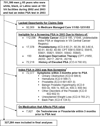Probability of an abnormal screening prostate-specific antigen result based on age, race, and prostate-specific antigen threshold
- PMID: 24439009
- PMCID: PMC3943595
- DOI: 10.1016/j.urology.2013.10.051
Probability of an abnormal screening prostate-specific antigen result based on age, race, and prostate-specific antigen threshold
Abstract
Objective: To determine the distribution of screening prostate-specific antigen (PSA) values in older men, and how different PSA thresholds affect the proportion of white, black, and Latino men who would have an abnormal screening result across advancing age groups.
Methods: We used linked national Veterans Affairs and Medicare data to determine the value of the first screening PSA test (ng/mL) of 327,284 men older than 65 years who underwent PSA screening in the Veterans Affairs health care system in 2003. We calculated the proportion of men with an abnormal PSA result based on age, race, and common PSA thresholds.
Results: Among men older than 65 years, 8.4% had a PSA >4.0 ng/mL. The percentage of men with a PSA >4.0 ng/mL increased with age and was highest in black men (13.8%) vs white (8.0%) or Latino men (10.0%) (P <.001). Combining age and race, the probability of having a PSA >4.0 ng/mL ranged from 5.1% of Latino men aged 65-69 years to 27.4% of black men older than 85 years. Raising the PSA threshold from >4.0 ng/mL to >10.0 ng/mL reclassified the greatest percentage of black men older than 85 years (18.3% absolute change) and the lowest percentage of Latino men aged 65-69 years (4.8% absolute change) as being under the biopsy threshold (P <.001).
Conclusion: Age, race, and PSA threshold together affect the pretest probability of an abnormal screening PSA result. Based on screening PSA distributions, stopping screening among men whose PSA <3 ng/mL means more than 80% of white and Latino men older than 70 years would stop further screening, and increasing the biopsy threshold to >10 ng/mL has the greatest effect on reducing the number of older black men who will face biopsy decisions after screening.
Copyright © 2014 Elsevier Inc. All rights reserved.
Conflict of interest statement
The authors report no conflicts of interest related to the work described in this manuscript.
Figures
Comment in
-
Editorial comment.Urology. 2014 Mar;83(3):605; discussion 605. doi: 10.1016/j.urology.2013.10.055. Epub 2014 Jan 16. Urology. 2014. PMID: 24439010 No abstract available.
References
-
- Moyer VA. Screening for prostate cancer: US Preventive Services Task Force recommendation statement. Annals of Internal Medicine. 2012;157(2):120–134. - PubMed
-
- Walter LC, Bertenthal D, Lindquist K, Konety BR. PSA screening among elderly men with limited life expectancies. JAMA: the Journal of the American Medical Association. 2006;296(19):2336–2342. - PubMed
-
- Prasad SM, Drazer MW, Huo D, Hu JC, Eggener SE. 2008 US Preventive Services Task Force Recommendations and Prostate Cancer Screening Rates. JAMA: the Journal of the American Medical Association. 307(16):1692–1694. - PubMed
-
- Bellizzi KM, Breslau ES, Burness A, Waldron W. Prevalence of cancer screening in older, racially diverse adults: still screening after all these years. Archives of Internal Medicine. 2011;171(22):2031–2037. - PubMed
-
- USPSTF. Guide to Clinical Preventative Services. 2nd ed. Alexandria, VA: International Medical Publishing; 2009.
Publication types
MeSH terms
Substances
Grants and funding
LinkOut - more resources
Full Text Sources
Other Literature Sources
Medical
Research Materials
Miscellaneous



